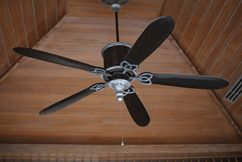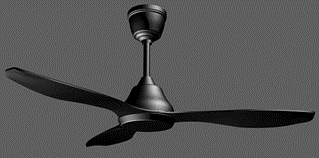
But choosing a ceiling fan can be complicated. You need to calculate the square footage of the room where you’re going to hang the ceiling fan, so you can choose the correct size and profile for your new fan. You need to appraise the prominent decorating elements in your home so you can choose a fan that will match. Here’s what you need to do.
Measure the Room Where the Fan Will Hang
When you want to buy a ceiling fan, the first thing you need to know is the square footage of the room where you’ll be hanging it. Fans come in all different sizes, but a fan that’s too small won’t work as well as an appropriately sized fan, and a fan that’s too large will work too well, creating a breeze that could be uncomfortably strong (not to mention, it could visually overpower the room through its sheer size).
Fans are measured across the diameter of the circle created when the blades spin, known as the sweep. So if you buy a 48-inch fan, it’s going to be four feet wide from blade-tip to blade-tip. That would likely be too large for a 150-square-foot kitchen, and too small for a 400-square-foot great room.
Measure the square footage of your room by measuring the length in feet of the longest wall and multiplying it by the length in feet of the shortest wall. If the room is 75 square feet or less, go for small fans under 36 inches in diameter. If the room is 76 to 144 square feet, go for fans 36 to 42 inches in diameter. If the room is 145 to 225 square feet, choose a fan 50 to 54 inches in diameter. And if the room is larger than 225 feet, either go for an oversized fan (56 inches or larger) or, if it’s a very large room (over 400 square feet), hang multiple fans.
Select the Right Fan Profile for Your Ceiling Height
Fans come in standard, extended, flush mount, and sloped ceiling profiles. Flush mount fans don’t have a downrod, but instead hug the ceiling — these are great for rooms with low ceilings under nine feet. Standard, extended, and sloped ceiling profiles all use a downrod to lower the fan to the appropriate height off the floor, which is eight to nine feet (although you can go as low as seven feet with a flush-mount fan in a low-ceilinged room). A standard downrod lowers the fan about three to five inches from the ceiling, while extended downrods can lower the fan up to 10 feet from the ceiling — these are ideal for rooms with very high ceilings. Sloped ceiling mounting kits are good for hanging a fan from a sloping ceiling, and you’ll need a special downrod kit if your ceiling slopes any more severely than 21 degrees.
Appraise Your Decorating Style
If you have a clear decorating style, it’s not that big of a deal to find a fan that coordinates. If you have a country farmhouse theme going on in your home, you can shop for rustic ceiling fans with distressed wood finishes and cast-iron hardware. If your home is tastefully appointed in a minimalist contemporary style, you can select a simple, modern fan 
Of course, you might have a more eclectic decorating style, one that combines elements of two or three different decorating styles into something that’s wholly your own. Think about which style appears most prominently in your room, and then select a ceiling fan that contrasts with that style.
Match Wood and Hardware Finishes
Don’t just match the design of your fan to your decorating style — take a good look at the most prominent wood and hardware finishes in your room and choose a fan with complementary wood and hardware colors. For example, if you’re hanging a ceiling fan in a kitchen with chrome cabinet knobs and pulls, and white cabinet fronts, grab a fan with chrome hardware and white blades. If you’re hanging a fan in a great room filled with antique mahogany furniture, choose a fan with dark mahogany blades and match the color of the hardware to your lightswitch and outlet plates.
Choosing a ceiling fan for your home isn’t always easy, especially with the wealth of design choices, finishes, and colors available on the market today. Think long and hard about the dominant decorating elements in your home, so you can choose a fan that won’t look out of place hanging from your ceiling.





